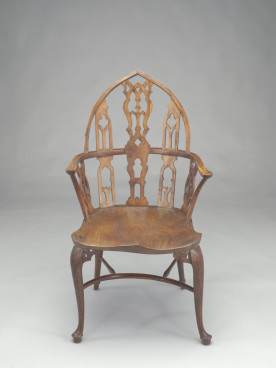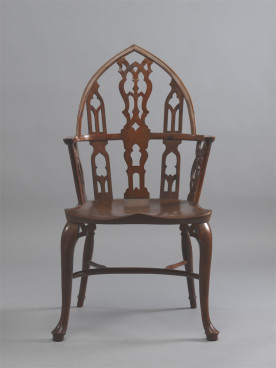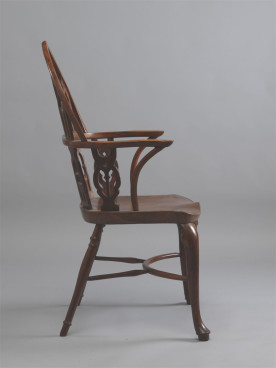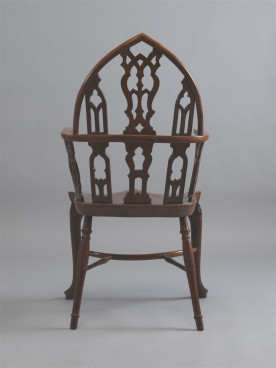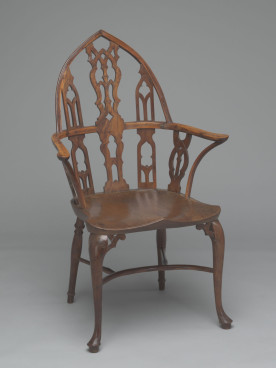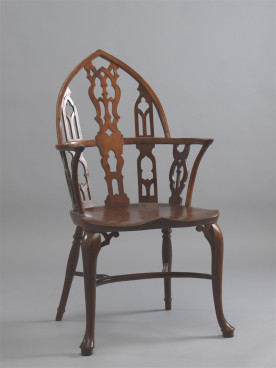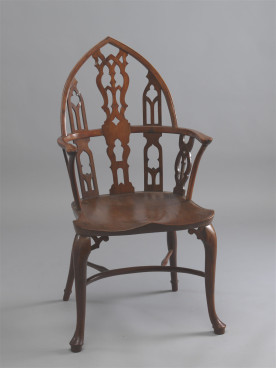Gothic Windsor chair, c.1770–1820
Yew and elm
This chair is one of a set of six.
Adam Bowett Catalogue (19/08/2012)
Description
A set of six ‘Gothick’ Windsor chairs, c.1790. The gothic arched back has three pierced splats, with a further two below the arm bow, and with backward-curved supports. The flared seat has a scribed moulding around the edge and is raised on cabriole forelegs with pierced brackets, joined by a bowed stretcher to turned back legs
Dimensions
H: 42” (107cm) Seat height: 18” (46cm) W: 21 ¼ ” (54cm) D: 25“ (64cm)
Materials
Yew, elm.
Dating criteria
The first ‘Gothick’ Windsors were probably made around the middle of the eighteenth century and they appear on trade cards in the second half of the eighteenth century. The relatively light proportions and in particular the turning profile of the back legs suggest a late eighteenth or early nineteenth century date.
Construction
The seat is solid elm, one piece. The legs are dowelled through the seat and cross wedged. The front legs are supported by pierced yew brackets nailed in place. The stretcher is in three parts, dowelled together and dowelled into front and back legs. Back legs are turned. The yew arm bow is supported by curved arm supports socketted through the seat and cross-wedged, and nailed up to the underside of the arm. It is further supported by the pierced side splats which are tenoned into the seat. All splats except the centre are fixed by small pegs driven in from the edge of the seat. The top bow is socketted into the arm and is joined at the apex by a pegged open mortise-and-tenon. The central splat is tenoned into the top bow and into the seat; the arm bow is rebated to receive it at the mid-point. The two flanking back splats are tenoned into the seat, passing vertically though slots in the arm bow, secured with a single peg, and are tenoned into the top bow. All three splats are secured at the top with small wooden pegs.
Marks or stamps
34.2 The underside of the seat is marked P, and in red crayon A/P
34.3 Indistinct chalk number or lettering to underside of seat.
34.4 Indistinct number or lettering to underside of seat in white chalk.
Condition
34.1 – This chair was never painted. All parts are original. The joints between the curved front stretcher and the two side stretchers are secured with nails, possibly original. Both arm supports are now screwed into the arm bow and plugged. There are two screws in the back of the arm bow passing into the centre splat. There is slight splitting top bow where the two flanking splats are tenoned . Some worm damage at the same point on the right side. Repaired breaks to the upper part of the centre splat, disguised and over painted at the back. The lower part of the lefthand splat has a cusp missing from the left side of the pierced arch.
34.2 – Sound, as for 34.1; small split left side arm bow. Nailed repair to apex of top bow, additional pegs or screws securing the two side splats to the seat. Right side underarm splat replaced.
34.3 – Filled split to right side front foot, filled worm damage left side arm terminal, nailed repair to the apex of the back bow.
34.4 – Sound. The arms have a marked downward slope.
Additional remarks
This is good set of a standard ‘Gothick’ design. Examples are shown in Cotton (1990), including (fig. TV21) a three-chair back settee with identical splat and bracket design. There is at least one chair of the same design in the Victoria and Albert Museum, but with an earlier style of back leg turning.
References
Bernard D. Cotton, The English Regional Chair, Woodbridge (1990), p. 47.
Tom Crispin, The English Windsor Chair, Stroud (1992).
Provenance
Purchased James C. Meers, January 1991


